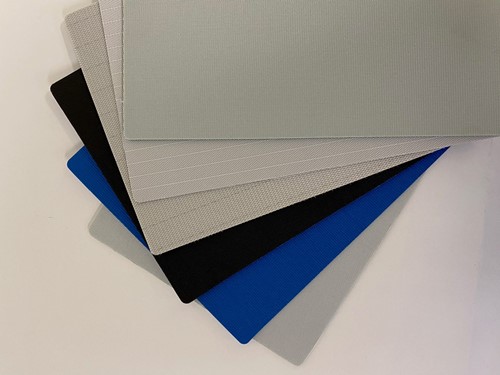''Customers sometimes ask me how I determine which type of conveyor belt is best suited for their application.'' This choice depends on a lot of different factors, such as the extent to which a belt must be stable in width, the extent to which products on the belt must detach easily from the surface or not, and whether a belt must be antistatic. The properties of a conveyor belt are closely related to the construction of the belt. In this series of blogs you will find information about the construction of conveyors. This blog is about the fabric in a conveyor belt.
Reading time 5 min.
Conveyor belts consist of different layers
The fabric reinforced plastic conveyor belts in the assortment of Bandtransport Europe are made up of different fabric and plastic layers. The layers of fabric in a conveyor belt form the carcass of the belt. The fabric largely determines the properties of a conveyor belt, including its flexibility and strength.
The fabric layers in the conveyor belt are embedded in thermoplastics, such as PVC (polyvinyl chloride), PU (polyurethane), PE (polyethylene), Polyester or silicones. At Bandtransport Europe conveyor belts can also be coated with Hytrel®, a strong, wear-resistant polyester plastic suitable for applications with heavy loads.
Properties of a conveyor belt are determined by weave pattern and yarns used
The weave not only determines the strength of the belt, but also its elongation, its longitudinal flexibility. The width stability, the flexibility in the width of the belt, is also closely related to the weave.
In addition, the fabric influences many other properties of a conveyor belt. For example, the fabric used can ensure that a belt is antistatic or has low stretch and shrinkage, or has high strength or tear resistance. A desired noise behavior, exhibit good adhesion activity, or possess the intended coefficient of friction is also another possibility. The properties of the fabric, and therefore the conveyor belt, are determined by the composition of the yarns used in combination with the weaving pattern.
Weaving pattern
A fabric consists of threads that are interwoven at right angles. The threads running in the longitudinal direction are called the warp threads. The weft threads run across the width of the fabric, these are the threads that cross the warp threads.
In weaving, a loom holds the warp threads in place. A weaving mechanism lifts or drops the warp threads. A bobbin pulls the weft threads through the gaps between the warp threads. The pattern in which the warp threads are lifted creates a specific weaving pattern.
The weaving pattern and the spacing of the threads in the pattern affect the required drum diameter. The weave pattern also influences other properties. For example, whisper weave has a very specific weave pattern that causes a different sound behavior. The use of whisper fabric reduces noise pollution on (longer) conveyor belts that transport boxes or luggage at high speed. Whisper fabric is also used for treadmills on jogging machines.
What are the characteristics of my application that make demands on my conveyor belt?
To ensure that your conveyor belt meets the right properties, choosing the right conveyor belt fabric is very important. What properties of your application are important when choosing your conveyor belt? And which conveyor belt fits best? Bandtransport Europe can give you excellent advice. Please do not hesitate to contact me or call +31 (0)251 319 119). I would be happy to help you!
What's next?
In the next blog I will tell more about the composition of the yarns used to make the fabric and how these yarns influence the properties of the conveyor belt.

Feel free to contact us. We'll be happy to assist.
Do you want to know more about our products? Contact us for more information or request a quotation.